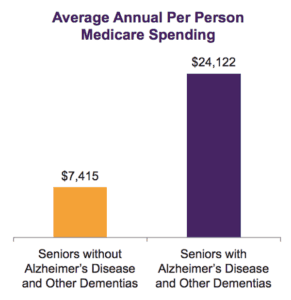
In the waning hours of 2018, President Trump signed into law a bipartisan bill to boost federal efforts to address the Alzheimer’s epidemic that impacts some 5.7 million Americans and their families. The BOLD Infrastructure for Alzheimer’s Act provides $100 million in new funding and “restates priorities” in the fight against a disease that’s aptly been called “The Long Goodbye.”
The BOLD Act was cosponsored by Senators Tim Kaine (D-VA), Susan Collins (R-ME), Shelley Moore Capito (R-WV), and Catherine Cortez-Masto (D-NV):
“The… Act will improve early detection and diagnosis, provide assistance for caregivers and educate the public on Alzheimer’s disease and brain health. This bipartisan legislation is the first step in addressing [this] ongoing public health crisis…” – Sen. Catherine Cortez-Masto, BOLD Act co-sponsor
The National Committee, which fights for the financial and health security of America’s seniors, endorsed the bill to confront Alzheimer’s (whose victims are mostly over 65 years of age).
“The BOLD Act would create a public health infrastructure to implement effective interventions to combat Alzheimer’s disease and related dementias including prevention, early detection and diagnosis and treatment.” – National Committee letter endorsing BOLD Act, 5/2/18
While it’s commendable that a bipartisan group of Senators sponsored the bill and that President Trump signed the BOLD ACT into law, defeating the Alzheimer’s epidemic will require much, much more. One-hundred million dollars in new spending over 5 years is a small step forward, and advocates for Alzheimer’s victims are right to celebrate. But federal funding for Alzheimer’s research continues to fall short of what is needed to invest in an aggressive and intensive research strategy to develop effective treatment and, hopefully, a cure.
Estimated federal spending on Alzheimer’s research was some $1.8 billion in 2018, compared to President Trump’s demand for $5.6 billion for his border wall. His administration’s Fiscal Year 2019 budget called for a freeze in biomedical research. A significant shift towards disease research priorities is urgently needed.
Alzheimer’s is a fatal scourge deserving considerably higher funding. It is the 6th leading cause of death in the United States, felling more Americans than breast and prostate cancer combined. A startling one in three seniors dies with Alzheimer’s or other form of dementia. By 2050, the disease is expected to claim 14 million victims – almost three times the number of Alzheimer’s patients today.
The disease also poses a direct threat to Medicare and Medicaid. In 2018, the two programs spent an estimated $186 billion caring for beneficiaries with Alzheimer’s and other dementias – representing nearly 70 percent of total costs. “By 2050, combined Medicare and Medicaid spending on patients with Alzheimer’s is expected to quadruple to $750 billion (in today’s dollars),” according to the nonprofit Alzheimer’s Impact Movement. This is an enormous financial burden for Medicare and Medicaid, which seniors’ advocates are already fighting to strengthen in the face of conservatives’ demands for benefit cuts.

Source: Alzheimer’s Impact Movement
The nearly six million Americans suffering from Alzheimer’s, along with their families and caregivers, rightly expect an increased funding commitment from the federal government. The beginning of the 116th Congress – with its fresh faces and new leadership – presents an opportunity to build on the BOLD Act and put more brain power into the fight. It’s time for our national leadership to muster the political will to defeat Alzheimer’s before the grim estimates for the future become reality.


